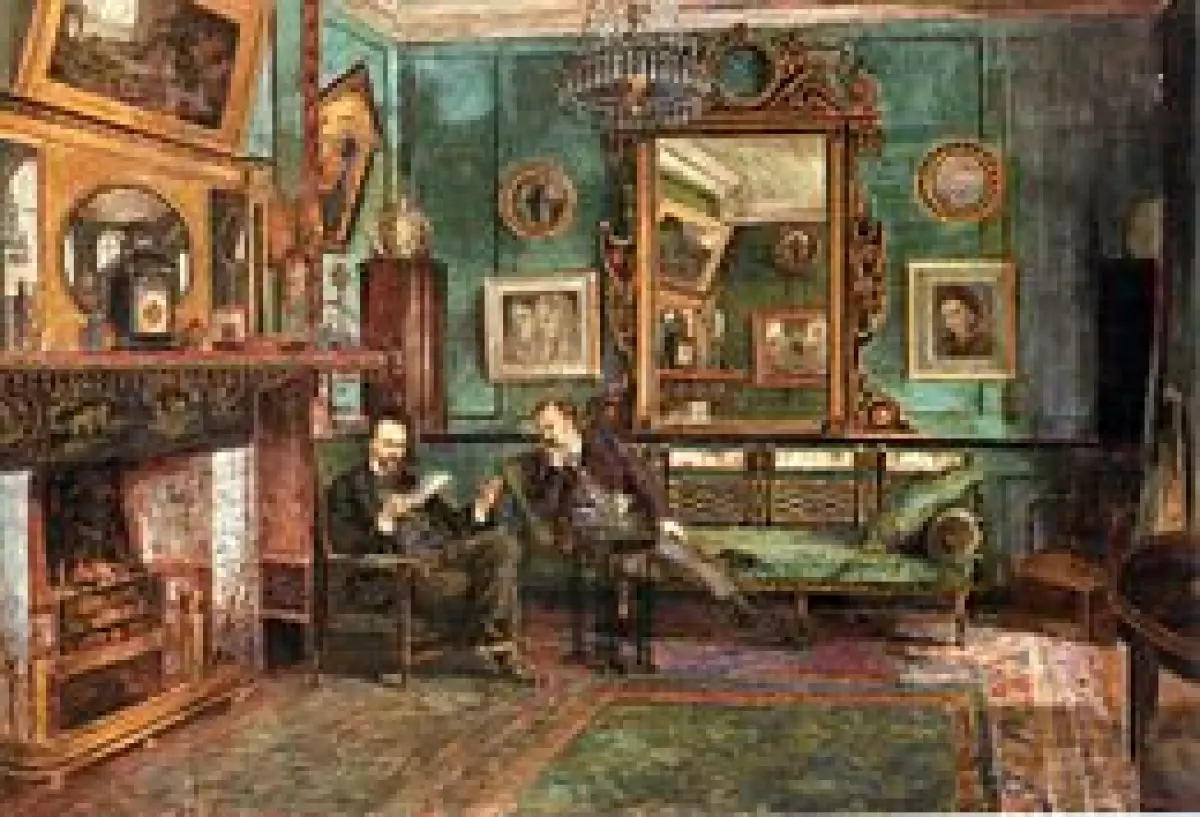 Image: Dante Gabriel Rossetti's drawing room at No. 16 Cheyne Walk, 1882, by Henry Treffry Dunn.
Image: Dante Gabriel Rossetti's drawing room at No. 16 Cheyne Walk, 1882, by Henry Treffry Dunn.
Victorian decorative arts transport us to a time of opulence and excess, where ornamentation flourished in every corner. This distinctive style emerged during the Victorian era, blending historic influences, Asian and Middle Eastern inspirations, and the creative brilliance of the time. From the Arts and Crafts movement to the aesthetic movement, Anglo-Japanese style, and Art Nouveau, the late Victorian era bore witness to a diverse range of artistic expressions.
Architecture: Marrying the Past and Present
Throughout this era, Victorian architecture embraced a fusion of styles, combining elements from various periods in history. From Gothic to Tudor, Elizabethan to Neoclassical, designers transformed and modified these styles to create architectural marvels that still stand today. This eclectic blend gave birth to a unique visual language, where the past and present intertwined harmoniously.
Interior Decoration and Design: Beauty in Every Detail
Orderliness and ornamentation defined the interior decoration and design of the Victorian era. Homes were carefully divided into public and private spaces, each exquisitely adorned to reflect the owner's interests and aspirations. The grand parlour took center stage, serving as a showcase for entertaining guests. Meanwhile, the dining room, with its ornate sideboard, captivated visitors with its intricate details.
Old Interiors: Unveiling the Elegance of the Past
Preserving the charm of the past, Victorian interiors transported inhabitants and visitors alike to another era. These preserved interiors provide a glimpse into the rich heritage of the Victorian period, with private spaces resonating with a sense of intimacy and history.
Preserved Interiors: A Gateway to the Past
Public spaces, too, witnessed the preservation of Victorian elegance. Step into these preserved interiors and be transported to bygone eras, where artistry and craftsmanship adorned every nook and cranny. The intricate details and timeless beauty of these spaces are a testament to the enduring allure of Victorian decorative arts.
Walls and Ceilings: A Canvas of Creativity
In Victorian homes, walls were more than just barriers; they were an opportunity for artistic expression. Paint colors were carefully chosen based on the room's purpose, with different shades and techniques used to create depth and texture. The introduction of linoleum by Frederick Walton revolutionized wall coverings, making it possible to achieve the appearance of wood or leather effortlessly. Ceilings, too, became works of art, adorned with exquisite ornamentation that showcased the homeowner's refined taste.
Wallpaper: A Tapestry of Stories
Wallpaper played a crucial role in Victorian decorative arts, with its wide range of designs becoming accessible to a growing number of households. Elaborate floral patterns in vibrant colors, such as red, blue, and yellow, graced the walls, while Gothic-inspired papers captivated with earthy tones and stylized motifs. The influential designer William Morris left an indelible mark on the wallpaper industry, drawing inspiration from Medieval and Gothic tapestries.
Furniture: Where History Meets Innovation
The Victorian era witnessed a diverse array of furniture styles, as designers drew from different historical periods to create their masterpieces. Gothic and Rococo revival styles were particularly prominent during this time, showcasing intricate carvings, luxurious fabrics, and attention to detail. Among the most iconic pieces of Victorian furniture is the Chevy Chase Sideboard by Gerrard Robinson, a testament to the era's craftsmanship and elegance.
Oscar Wilde's Aesthetic of Victorian Decoration: Beauty as a Path to Enlightenment
One cannot discuss Victorian decorative arts without mentioning Oscar Wilde, a literary figure who championed individualism and aestheticism. Wilde believed that by transforming their immediate surroundings, individuals could elevate their minds, embracing the cosmopolitan ideals of the era. He drew inspiration from thinkers like Alexander von Humboldt, who believed that imagination could be nurtured through organic elements and an appreciation of beauty. Through his work, Wilde sought to inspire others to immerse themselves in the aesthetical, allowing their true selves to flourish.
In Conclusion
Victorian decorative arts embody a rich tapestry of history, creativity, and cultural influences. From the grandeur of architecture to the intricate details of interior design, every aspect reflects the opulence and artistic brilliance of the era. Let us journey back in time, marvel at the beauty of Victorian decorative arts, and draw inspiration from the past to create a more beautiful future.
References:
- Victorian Furniture
- Victorian Room Virtual Tour
- Victorian Design (victorianweb.org) including ceramics, furniture, glass, jewelry, metalwork, and textiles.
- Early Victorian Furniture History in England
- Interior decoration and design
- Late Victorian Era Furniture History in England
- Victorian Bookmarks
- "Victorian Furniture Styles". Furniture. Victoria and Albert Museum. Archived from the original on 2010-11-19. Retrieved 2011-04-03.
- The history of wallcoverings and wallpaper
- Interior design: Victorian - National Trust
















